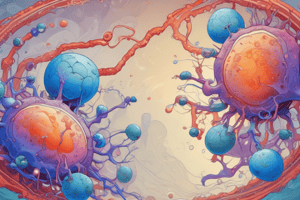Podcast
Questions and Answers
Elie Metchnikoff coined the term '______' which means the eating of cells.
Elie Metchnikoff coined the term '______' which means the eating of cells.
phagocytosis
The first viral agent identified was the '______' virus, affecting tobacco leaves.
The first viral agent identified was the '______' virus, affecting tobacco leaves.
Tobacco mosaic
Ronald Ross proved that '______' were the vital link in malaria transmission.
Ronald Ross proved that '______' were the vital link in malaria transmission.
mosquitoes
Karl Landsteiner identified the three blood groups A, B, and '______'.
Karl Landsteiner identified the three blood groups A, B, and '______'.
Theobald Smith and Salmon observed that high saline concentration could '______' bacteria.
Theobald Smith and Salmon observed that high saline concentration could '______' bacteria.
Landsteiner found that blood transfusion between persons with the same blood group did not lead to the destruction of blood cells, whereas this occurred between persons of different ______.
Landsteiner found that blood transfusion between persons with the same blood group did not lead to the destruction of blood cells, whereas this occurred between persons of different ______.
In the 1890’s, Ehrlich proposed a theory of immunity in which ______ were responsible for immunity.
In the 1890’s, Ehrlich proposed a theory of immunity in which ______ were responsible for immunity.
Fleming observed that the growth of the bacterium staphylococcus aureus was inhibited in the areas surrounding the colony of a mold called ______.
Fleming observed that the growth of the bacterium staphylococcus aureus was inhibited in the areas surrounding the colony of a mold called ______.
Watson and Crick, along with Franklin and Wilkins, determined the structure of ______.
Watson and Crick, along with Franklin and Wilkins, determined the structure of ______.
The one gene, one polypeptide hypothesis was studied by George W. Beadle and Edward L. Tatum using the bread mold, ______.
The one gene, one polypeptide hypothesis was studied by George W. Beadle and Edward L. Tatum using the bread mold, ______.
Flashcards are hidden until you start studying
Study Notes
Elie Metchnikoff and Immunology
- Coined the term "phagocytosis," meaning "the eating of cells," in 1884.
- Documented phagocytosis as a defense mechanism where white blood cells (WBCs) engulf and destroy microorganisms.
- Formulated foundational theory of immunology emphasizing cellular immunity through leukocyte action.
- Awarded the Nobel Prize in Physiology or Medicine in 1908.
- Contributed to Bacillus bulgaricus therapy, linking intestinal microbes to health.
- Proposed that streptococci and lactobacilli in yogurt occupy the intestine, displacing pathogenic organisms.
Contributions of Other Scientists
- Raymond Sabouraud developed culture media for yeast and mold studies.
- Chamberland created the first bacterial filter using unglazed porcelain, preventing bacteria from passing through.
- Berkefeld noted that filtered fluids were bacteria-free but still contained toxins that caused disease.
- Ivanovski discovered in 1892 that the Tobacco mosaic virus could pass through bacterial filters, identifying the first known virus.
- Ronald Ross confirmed mosquitoes as the transmission vectors for malaria, earning the Nobel Prize in 1902.
Key Discoveries in Bacteriology and Blood Groups
- Theobald Smith and Salmon studied saline solutions, discovering that high concentrations kill bacteria (osmotic principle).
- Karl Landsteiner identified blood types A, B, and O, and later the Rh factor, explaining blood agglutination due to surface protein antigens and plasma antibodies.
- Found that transfusions between same blood groups prevent cell destruction, while mismatched groups lead to agglutination; awarded the Nobel Prize in 1930.
Paul Ehrlich and Chemotherapy
- Proposed an immunity theory in the 1890s, stating antibodies are crucial for immunity (antitoxin).
- Regarded as the father of modern chemotherapy, theorized the existence of a "magic bullet" for targeting pathogens.
- Developed a staining method for identifying tubercle bacilli.
Alexander Fleming and Antibiotics
- In 1928 observed that Staphylococcus aureus growth was inhibited by Penicillium notatum mold.
- Identified penicillin as the active compound disrupting bacterial growth.
Advances in Genetics and Molecular Biology
- Selman Waksman contributed to the discovery of several antibiotics including Tetracycline and Streptomycin.
- George W. Beadle and Edward L. Tatum examined gene-enzyme relationships using Neurospora, proposing the one gene, one polypeptide hypothesis.
- Salvadore Luria and Max Delbruck demonstrated spontaneous mutations in bacteria, independent of environmental direction.
- Oswald T. Avery, Colin M. MacLeod, and Maclyn McCarty provided evidence that DNA is the genetic material responsible for heredity.
- Watson, Crick, Franklin, and Wilkins determined the double-helix structure of DNA in 1953.
- The 1970s saw the emergence of recombinant DNA technology and advances in genetic engineering, revolutionizing microbiology.
Studying That Suits You
Use AI to generate personalized quizzes and flashcards to suit your learning preferences.




